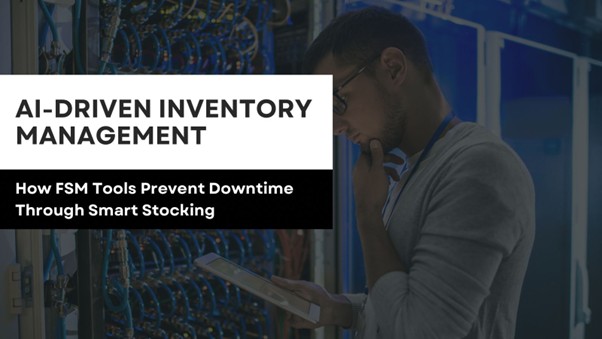AI-Driven Inventory Management: How FSM Tools Prevent Downtime Through Smart Stocking

CEOs and CTOs, this is a wake-up call! Downtime is a silent revenue killer. Downtime isn’t just an IT issue; it’s an operational and customer satisfaction issue. Every minute a critical system is down, dollars are flying out the door. A Siemens report in 2024 revealed that unplanned downtime saps 11% of annual revenues for the world’s 500 biggest companies – amounting to $1.4 trillion lost per year. In sectors from manufacturing to telecommunications, a single missing part can halt operations, costing hundreds of thousands per hour.
Field service organizations have learned the hard way that a spare part arriving late can trigger millions in losses. This is where AI-driven inventory management comes in. Modern field service management (FSM) tools – like those from FieldEZ – are harnessing AI for smart parts management to ensure the right components are in the right place at the right time, preventing costly downtime before it happens.
The High Cost of Downtime in Field Service
Downtime has always been expensive, but recent data shows it’s getting even costlier. Across all industries, 98% of organizations say that a single hour of downtime costs them over $100,000. For many, it’s far more.
- An automotive factory can lose about $3 million per hour when a production line stops.
- In energy, an hour of grid downtime averages $2.48 million.
- The telecom sector bleeds roughly $2 million per hour during network outages.
- No industry is immune – media companies might lose a comparatively modest $90k/hour,
- Retailers spend about $1.1M/hour, but multiply that by multi-hour outages and the impact is huge.
Unscheduled downtime now cuts so deep that for some industrial giants it’s dubbed a “money furnace.” As Tesla’s CEO famously quipped, idle factories burn cash continuously. The chart below illustrates the staggering cost of one hour of downtime in various industries, underscoring why minimising downtime is a C-suite priority:
For field service leaders, these figures aren’t abstract – they translate directly to service level agreements, revenue, and reputation. Every hour a customer’s equipment is offline, service providers risk SLA penalties and customer churn. This puts immense pressure on field teams to fix issues fast. However, speed is impossible if the necessary spare part isn’t on hand. The next sections explore how traditional inventory shortcomings contribute to downtime and how AI-driven FSM tools are solving that through smart stocking.
Inventory Woes: Stockouts, Overstock, and Lost Uptime
One of the biggest causes of protracted downtime in field service is not having the right stock available in one go. A crucial component is frequently missing, making it impossible for field specialists to finish a repair on their first visit. One in four service calls necessitate a follow-up visit, according to industry benchmarks, which show that the average first-time fix rate is roughly 75%.
According to Aberdeen Group research, those incomplete calls require an average of 1.6 additional dispatches to fully resolve the issue. Why the extra trips? Each extra truck roll is expensive – roughly $200 to $300 per service call in direct operational cost– and that doesn’t even count the revenue lost while the customer’s equipment remains down. In the meantime, the clock is ticking on downtime: a machine or system sits idle until the part is procured and a tech returns to install it.
To put the field service inventory challenge in perspective, here are a few key metrics:
Field Service Metric | Industry Average |
First-time fix rate (FTF) | |
Avg. extra dispatches if no first-time fix | |
Cost per additional truck roll | |
Customers demanding 1-visit resolution |
Beyond field service, poor inventory management has staggering costs across the economy. For instance, it is estimated that inventory mis-optimisation, also known as “inventory distortion,” will cost merchants $1.77 trillion globally in 2023. Losses from overstocks (extra inventory that frequently ends up being discounted or discarded) and stockouts (when products are unavailable) are included in this figure. In 2023, overstocks will cause an additional $562 billion in losses, while out-of-stock items will be responsible for around $1.2 trillion in missed sales. The pie chart below shows the breakdown:
In field service, a “stockout” means downtime and lost revenue, while “overstock” implies capital tied up in parts that gather dust.
For field service organisations, the lesson from retail is pertinent: failing to balance supply and demand effectively costs money. Smart parts management aims to eliminate both extremes – and AI is the key to achieving that balance.
AI to the Rescue: Smart Stocking through Prediction and Automation
Artificial intelligence is fundamentally changing how companies manage spare parts and inventory, enabling what we can truly call smart stocking. Instead of reactive or static inventory policies, AI-driven systems bring predictive intelligence and automation to ensure the right parts are available before downtime happens. Here’s how AI is transforming inventory management in FSM:
- Predictive Demand Forecasting: AI excels at finding patterns in historical usage data, failure rates, seasonal trends, and even real-time equipment sensor readings. This means FSM platforms can forecast which parts will be needed, where, and when – with far better accuracy than manual methods. In fact, AI-driven inventory software can forecast demand with 40% greater accuracy than traditional systems. By analyzing maintenance history and IoT sensor data, AI might flag that a certain pump or circuit board is likely to fail in the next 10 days, and prompt you to have a replacement ready. McKinsey research backs this up: implementing predictive maintenance analytics can reduce machine downtime by up to 50% by addressing issues before they cause a failure.
- Optimized Stock Levels (No More Stockouts or Overstock): AI-based inventory optimization considers countless variables – usage trends, lead times, service contracts, even weather forecasts – to set optimal stocking levels for each part. This ensures you’re not hoarding expensive parts you won’t use, but also not running out of critical items. As one field service technology expert explained, IoT devices now track inventory in real time while AI optimization “predicts demand for parts and tools, ensuring optimal stock levels. In retail, AI-driven inventory systems have cut excess stock by up to 30% while still preventing stockout.. Smart stocking, powered by AI, strikes that fine balance that humans with spreadsheets often miss.
- Automated Replenishment and Procurement: Gone are the days of waiting for a quarterly review to reorder parts. AI keeps a continuous pulse on inventory levels. When stock for a part falls below a dynamic threshold, an AI-driven FSM system can trigger an automatic reorder or transfer request, just in time for the next jobs. For example, if an AI notices a spike in demand for a specific HVAC component during summer months, it will proactively raise reorder levels for that season. On the flip side, if a certain part hasn’t been used in a while, AI might suggest holding off on replenishment or even rebalancing that stock to a region where it’s needed.
This fusion of predictive analytics and automation is what we refer to as smart parts management. It transforms inventory from a static, reactive cost centre into a dynamic system that actively works to prevent downtime.
Cross-Industry Impact of Smart Stocking
AI-driven inventory management isn’t just a theory – it’s being applied across industries to great effect. Consider a few scenarios:
- Manufacturing: In a car manufacturing plant, assembly robots and machines have dozens of components that can wear out. Now, with AI monitoring machine data, the system predicts which part will likely fail in the next maintenance cycle and makes sure it’s in stock at the plant beforehand. This proactive approach is critical when the automotive industry loses $2.3 million per hour of downtime on average. By smart stocking critical spares, manufacturers avoid those multi-million dollar surprises.
- Energy & Utilities: Electric utilities use vast networks of transformers, switches, and pumps – any of which can knock out service if they fail. AI-based asset management helps predict failures (for example, a substation transformer showing signs of overheating) and ensures the replacement unit or repair kit is ready at a nearby depot. Given the energy sector’s downtime costs around $2.5M per hour, preventing a prolonged outage is not just about money but also about reliability to customers and publicsafety.
- Telecommunications: Telecom companies often boast about “five nines” uptime (99.999% availability), and they leverage AI to get there. For instance, telecom providers maintain spare fibre optic cables, routers, and tower components. AI analyses network data and maintenance records to predict which network elements are likely to go down and pre-stocks spares in strategic locations. By using AI, one large telecom operator notably reduced network downtime incidents by predicting electronics failures a month in advance – something that simply wasn’t possible without machine learning crunching the numbers.
FieldEZ’s AI-Driven FSM Approach (Case in Point)
Leading FSM software providers are already bringing these AI capabilities to their customers. FieldEZ is one example of how AI-driven inventory management is implemented in practice. FieldEZ’s platform offers a centralized inventory system, meaning managers get a unified, real-time view of stock levels across all warehouses, hubs, and even field technicians’ van inventory.
FieldEZ’s AI ensures each asset in the inventory is accounted for and tracked – if a technician uses a part on a job, the inventory auto-updates, and if that usage brings the stock below a threshold, FieldEZ’s system can initiate a restock request automatically. According to FieldEZ, its AI features predict demand for parts and automate replenishment, making sure field techs have the right tools and components when they need them. In essence, the software builds the “smart stocking” principles directly into daily operations.
Companies that use FSM systems like FieldEZ have experienced lower mean time to repair and higher first-time fix rates, which is a significant outcome of these integrated capabilities. In order to reduce delays, paperwork, and guesswork, FieldEZ helps organisations standardise workflows and integrate AI at critical decision points. Reduced downtime for the end user and increased productivity and profit for the service provider are the true benefits.
Conclusion!
In the modern service landscape, preventing downtime has become just as important as fixing problems quickly. AI-driven inventory management shifts the mindset from reactive firefighting (“We’ll fix it as fast as we can once it breaks”) to proactive assurance (“We’ll make sure it doesn’t break in the first place due to lack of parts”). When you can confidently tell a client that you have 99% first-visit resolution or near-zero unplanned downtime because your supply chain is that intelligent – that’s a competitive differentiator.
It’s no wonder that C-suite leaders across industries are investing in what we might call “FSM inventory AI” solutions: the synergy of field service management, inventory optimization, and artificial intelligence. For CEOs and CTOs, the message is clear: investing in these technologies is not just about efficiency – it’s about resilience, agility, and leadership in the market.



